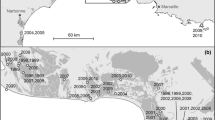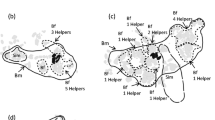Abstract
In multitudinous breeding colonies, kin interactions could go unnoticed because we are unaware of the kinship among adults we observe. Evidence of cooperation and competition between close adult kin in a blue-footed booby colony was sought by analyzing patterns of natal dispersal and proximity of nests. Male and female recruits nested closer to their own natal sites than to their parents’ current sites. Males (only) dispersed less far when both parents were present than when no parent or one parent was present, but not selectively close to fathers versus mothers when these were divorced. Neither parental presence nor parental proximity affected breeding success of recruits of either sex. Although distances between the nests of simultaneously recruiting broodmates were unrelated to their sex, males dispersed 13.1 m less when a sister was present than when a brother was present. Neither sex was affected in its dispersal distance by the presence or hatching order/dominance of a broodmate. Neither sex was affected in its breeding success by the presence versus absence of a broodmate, although female success increased with proximity of their brothers. Parents and sisters may actively or passively help males establish their first territories near their natal sites and nearby brothers may help females in their first breeding attempts; otherwise, boobies do not influence each other’s natal dispersal and first breeding success. It appears that boobies do not nest selectively close to or far from their parents, offspring, or broodmates. Why there is apparently so little cooperation and altruism between close adult relatives in booby colonies is puzzling.




Similar content being viewed by others
References
Baglione V, Canestrari D, Marcos JM, Ekman J (2003) Kin selection in cooperative alliances of carrion crows. Science 300:1947–1949
Beecher MD (1981) Development of parent-offspring recognition in birds. In: Aslin R, Alberts J, Petersen M (eds) Development of Perception, vol 1. Academic Press, New York, pp 45–65
Beecher MD (1982) Signature systems and kin recognition. Amer Zool 22:477–490
Bowler DE, Benton TG (2005) Causes and consequences of animal dispersal strategies: relating individual behaviour to spatial dynamics. Biol Rev 80:205–225
Chavez-Peón C, Castillo-Alvarez A (1983) Ecología reproductiva e influencia del comportamiento en el control del número de crias en el bobo de patas azules, Sula nebouxii, en la Isla Isabel. Universidad Nacional Autónoma de México, Nay Dissertation
Comins HN, Hamilton WD, May RM (1980) Evolutionary stable dispersal strategies. J Theor Biol 82:205–230
Crawley MJ (2005) Statistics: an introduction using R. John Wiley and Sons, Chichester
R Development Core Team (2006) R: A language and environment for statistical computing. R Foundation for Statistical Computing, Vienna, Austria; Available from http://www.R-project.org
Dhondt AA (1979) Summer dispersal and survival of juvenile great tits in southern Sweden. Oecologia 42:139–157
Drummond H, Osorno JL (1992) Training siblings to be submissive losers: dominance between booby nestlings. Anim Behav 44:881–893
Drummond H, Gonzalez E, Osorno JL (1986) Parent-offspring cooperation in the blue-footed booby (Sula nebouxii). Behav Ecol Sociobiol 19:365–372
Drummond H, Torres R, Krishnan VV (2003) Buffered development: resilience after aggressive subordination in infancy. Am Nat 161:794–807
Eikenaar C, Richardson DS, Brouwer L, Komdeur J (2007) Parent presence, delayed dispersal, and territory acquisition in the Seychelles Warbler. Behav Ecol 18:874–879
Ekman J (2006) Family living among birds. J Avian Biol 37:289–298
Ekman J, Eggers S, Griesser M (2002) Fighting to stay: the role of sibling rivalry for delayed dispersal. Anim Behav 64:453–459
Ellsworth DS, Belthoff JR (1999) Effects of social status on the dispersal behaviour of juvenile western screech-owls. Anim Behav 57:883–892
Gandon S, Michalakis Y (1999) The Evolution of dispersal in a metapopulation with extinction and kin competition. J Theor Biol 199:275–290
Gayou DC (1986) The social system of the Texas green jay. Auk 103:540–547
Gonzalez E, Osorno JL (1987) Dinámica de la territorialidad en una colonia de bobo de patas azules, Sula nebouxii, en Isla Isabel. Universidad Nacional Autónoma de México, Nayarit Dissertation
Hamilton WD, May RM (1977) Dispersal in stable habitats. Nature 269:578–581
Jacquot JJ, Vessey SH (1995) Influence of the natal environment on dispersal of white-footed mice. Behav Ecol Sociobiol 37:407–412
Kim S-Y, Torres R, Rodríguez C, Drummond H (2007a) Effects of breeding success, mate fidelity and senescence on breeding dispersal of male and female blue-footed boobies. J Anim Ecol 76:471–479
Kim S-Y, Torres R, Domínguez CA, Drummond H (2007b) Lifetime philopatry in the blue-footed booby. Behav Ecol 18:1132–1138
Kim S-Y, Torres R, Drummond H (2009) Simultaneous positive and negative density-dependent dispersal in a colonial bird species. Ecology 90:230–239
Komdeur J, Hatchwell BJ (1999) Kin recognition: function and mechanisms in avian societies. Trends Ecol Evol 14:237–241
Lambin X, Krebs CJ (1993) Influence of female relatedness on the demography of Townsend’s vole populations in spring. J Anim Ecol 62:536–550
Lambin X, Yoccoz NG (1998) The impact of population kin-structure on nestling survival in Townsend’s voles, Microtus townsendii. J Anim Ecol 67:1–16
Lambin X, Aars J, Piertney S (2001) Dispersal, intraspecific competition, kin competition and kin facilitation. In: Clobert J, Danchin E, Dhondt AA, Nichols JD (eds) Dispersal. Oxford University Press, Oxford, pp 123–142
Le Galliard JF, Gundersen G, Andreassen HP, Stenseth NC (2006) Natal dispersal, interactions among siblings and intrasexual competition. Behav Ecol 17:733–740
Léna JP, Clobert J, de Praipont M, Lecomte J, Guyot G (1998) The relative influence of density and kinship on dispersal in the common lizard. Behav Ecol 9:500–507
Massot M, Clobert J (2000) Processes at the origin of similarities in dispersal behaviour among siblings. J Evol Biol 13:707–719
Montes-Medina AC, Drummond H, Kim S-Y (2009) Distance from the forest edge matters in habitat selection of the blue-footed booby Sula nebouxii. J Ornithol. doi:10.1007/s10336-009-0405-3
Nakagawa S, Waas JR (2004) O sibling, where art thou?—a review of avian sibling recognition with respect to the mammalian literature. Biol Rev 79:101–109
Nelson JB (1978) The sulidae: gannets and boobies. Oxford University Press, Oxford
Osorio-Beristain M, Drummond H (1993) Natal dispersal and deferred breeding in the blue-footed booby. Auk 110:234–239
Osorio-Beristain M, Drummond H (1998) Non-aggressive mate-guarding by the blue-footed booby: a balance of female and male control. Behav Ecol Sociobiol 43:307–315
Osorio-Beristain M, Drummond H (2001) Male boobies expel eggs when paternity is in doubt. Behav Ecol 12:16–21
Osorio-Beristain M, Perez-Staples D, Drummond H (2006) Does booby egg dumping amount to quasi-parasitism? Ethology 12:625–630
Payne RB (1991) Natal dispersal and population structure in a migratory songbird, the indigo bunting. Evolution 45:49–62
Perrin N, Goudet J (2001) Inbreeding, kinship and the evolution of natal dispersal. In: Clobert J, Danchin E, Dhondt AA, Nichols JD (eds) Dispersal. Oxford University Press, Oxford, pp 110–122
Perrin N, Lehmann L (2001) Is sociality driven by costs of dispersal or the benefits of philopatry? A role for kin discrimination mechanisms. Am Nat 158:471–483
Pomeroy PP, Twiss SD, Redman P (2000) Philopatry, site fidelity and local kin associations within grey seal breeding colonies. Ethology 106:899–919
Queller DC (1992) Does population viscosity promote kin selection? Trends Ecol Evol 7:322–324
Queller DC (1994) Genetic relatedness in viscous populations. Evol Ecol 8:70–73
Richner H, Heeb P (1996) Is the information center hypothesis a flop? Adv Study Behav 24:1–45
Ronce O, Gandon S, Rousset F (2000) Kin selection and natal dispersal in an age-structured population. Theor Popul Biol 58:143–159
Stamps J, Calderón-de Anda M, Perez C, Drummond H (2002) Collaborative tactics for nest site selection by pairs of blue footed boobies. Behaviour 139:1383–1412
Strickland D (1991) Juvenile dispersal in gray jays: dominant brood member expels siblings from natal territory. Can J Zool 69:2935–2945
Taylor PD (1992) Altruism in viscous populations: an inclusive fitness model. Evol Ecol 6:352–356
Van Noordwijk AJ (1984) Problems in the analysis of dispersal and a critique on its “heritability” in the great tit. J Anim Ecol 53:533–544
Velando A, Drummond H, Torres R (2006) Senescent birds redouble reproductive effort when ill: confirmation of the terminal investment hypothesis. Proc R Soc Lond B Biol Sci 273:1443–1448
Ward P, Zahavi A (1973) The importance of certain assemblages of birds as “information-centers” for food finding. Ibis 115:517–534
Watts CR, Stokes AW (1971) The social order of turkeys. Sci Am 224:112–118
West SA, Pen I, Griffin AS (2002) Cooperation and competition between relatives. Science 296:72–75
Wheelwright NT, Mauck RA (1998) Philopatry, natal dispersal, and inbreeding avoidance in an island population of savannah sparrows. Ecology 79:755–767
Williams DA, Rabenold KN (2005) Male-biased dispersal, female philopatry, and routes to fitness in a social corvid. J Anim Ecol 74:150–159
Zar JH (1999) Biostatistical analysis. Prentice Hall, New Jersey
Acknowledgments
We thank David Queller, Carlos Cordero, César Domínguez, and Juan Nuñez for very helpful discussion of the results, two anonymous reviewers for constructive comments on the manuscript, V. V. Krishnan for the program that expresses nest locations, and José Luis Osorno and numerous volunteers for dedicated work in the field. Fieldwork depended on the generous support of many fishermen, the Secretaría del Medioambiente y Recursos Naturales, and the Mexican Navy. Finance was provided by the Consejo Nacional de Ciencia y Tecnología (4722-N9407, C01-47599, D112-903581, PCCNCNA-031528), the Universidad Nacional Autónoma de México (IN211491), the National Geographic Society (3065-85, 4535-91), and the Conservation and Research Foundation. S.-Y. Kim was supported by a postdoctoral fellowship of the Universidad Nacional Autónoma de México.
Author information
Authors and Affiliations
Corresponding author
Additional information
Communicated by I. Hartley
Rights and permissions
About this article
Cite this article
Drummond, H., Torres, R., Rodríguez Juarez, C. et al. Is kin cooperation going on undetected in marine bird colonies?. Behav Ecol Sociobiol 64, 647–655 (2010). https://doi.org/10.1007/s00265-009-0882-7
Received:
Revised:
Accepted:
Published:
Issue Date:
DOI: https://doi.org/10.1007/s00265-009-0882-7




